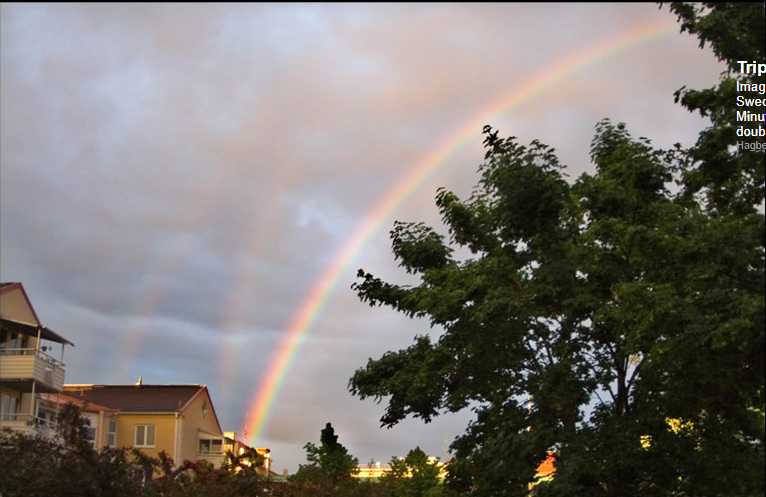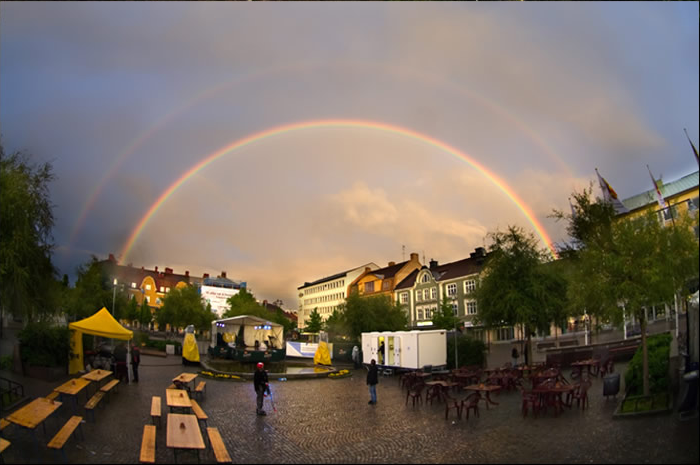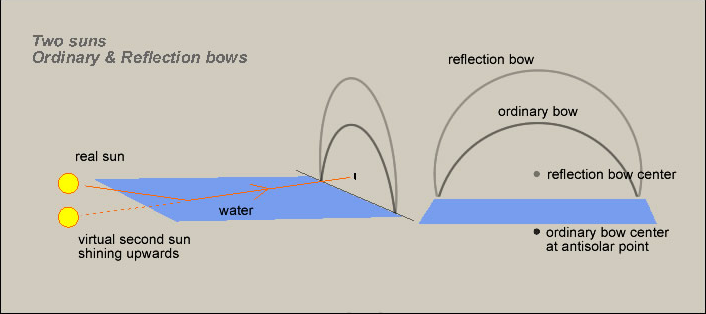Triple & double rainbows, Sweden
Triple & Double Rainbows: A Phenomenon in Sweden
Rainbows have long fascinated people with their vibrant colors and ethereal beauty. While single rainbows are commonly observed, there are rare instances when nature surprises us with the spectacle of multiple rainbows. In this article, we delve into the captivating phenomenon of triple and double rainbows, focusing on a remarkable sighting in Sweden.
The Triple Rainbow Phenomenon
In June 2009, Måns Hagberg had a remarkable encounter with a triple rainbow on Sweden's National Day. Captured in a stunning photograph, the image reveals the three distinct arcs of color adorning the sky. The innermost arc is the primary rainbow, while the outermost is the secondary rainbow. However, it is the middle arc that piques our curiosity.
Unraveling the Mystery of the Reflection Rainbow
The middle bow, known as the reflection rainbow, presents a unique optical phenomenon. Unlike the primary and secondary rainbows, which result from refraction and reflection within raindrops, the reflection rainbow requires a horizontal reflecting surface to form. In Hagberg's case, this reflective surface was a lake situated approximately two miles away.
The Role of Reflecting Surfaces
It is important to note that the reflecting surface need not be continuous. Even a series of small pools can collectively create a sufficient reflective area to generate the reflection rainbow. As long as these bodies of water are positioned along the line connecting the observer's eye and the sun, they can serve as effective mirrors for sunlight.
How Reflection Rainbows Are Formed
When sunlight encounters the reflecting surface, upward-going rays are reflected, forming the reflection rainbow. Conceptually, one can imagine it as if a second sun were shining from beneath the horizon. The center of this reflection rainbow appears directly opposite in the sky, at the same distance above the horizon as the centers of the primary and secondary rainbows are beneath it.
Exploring Possible Explanations
Hagberg suggests that the presence of a weedy and shallow lake, along with wet cobbles, pavements, and puddles, may have contributed to the formation of the reflection rainbow. These wet surfaces would have provided the necessary conditions for sunlight to bounce off and create the captivating phenomenon.
Triple and Double Rainbows: A Rarity
While triple and double rainbows are undoubtedly awe-inspiring, they are relatively rare occurrences. The conditions must align perfectly for these multiple rainbows to manifest. Not only must there be a suitable reflecting surface, but the sunlight must also hit the water droplets at just the right angle to create the primary and secondary rainbows. Consequently, witnessing a triple or double rainbow is a remarkable and unforgettable experience.
Conclusion
The beauty of atmospheric optics lies in its ability to surprise and enchant us with extraordinary displays of light. The phenomenon of triple and double rainbows, exemplified by Måns Hagberg's sighting in Sweden, serves as a testament to nature's artistry. By understanding the role of reflecting surfaces and the formation of reflection rainbows, we gain a deeper appreciation for the intricate interplay between light, water, and the atmosphere. While these celestial wonders may be elusive, their splendor continues to captivate and inspire us to explore the marvels that exist right above our heads.

Triple Rainbow, Sweden
Imaged by M�ns Hagberg on Sweden's National Day, June 6, '09. Minutes later he saw the brilliant double bow of the lower image. �M�ns Hagberg, shown with permission.

The middle bow, raked upwards more sharply than the inner primary and outer secondary, is a 'reflection rainbow'. A horizontal reflecting surface is need to produce it.
�There is a lake about two miles away - a weedy, shallow one more of a bird sanctuary than glittering water. But it does line up between the sun and the bow center.�
�There were .also. a lot of wet cobbles, wet pavements and puddles that might explain low parts of the reflection bow."
The reflecting surface need not be continuous. A number of small pools will suffice provided they collectively have sufficient area to reflect enough sunlight and are on the line joining the eye and the sun.
Upward going rays reflected from the watery mirror form the bow. Think of it as formed by a second sun shining from beneath the horizon. The bow centre directly opposite in the sky is then the same distance above the horizon as the centre of the ordinary primary and secondary bows is beneath it.

Note: this article has been automatically converted from the old site and may not appear as intended. You can find the original article here.
Reference Atmospheric Optics
If you use any of the definitions, information, or data presented on Atmospheric Optics, please copy the link or reference below to properly credit us as the reference source. Thank you!
-
<a href="https://atoptics.co.uk/blog/triple-double-rainbows-sweden/">Triple & double rainbows, Sweden</a>
-
"Triple & double rainbows, Sweden". Atmospheric Optics. Accessed on November 26, 2024. https://atoptics.co.uk/blog/triple-double-rainbows-sweden/.
-
"Triple & double rainbows, Sweden". Atmospheric Optics, https://atoptics.co.uk/blog/triple-double-rainbows-sweden/. Accessed 26 November, 2024
-
Triple & double rainbows, Sweden. Atmospheric Optics. Retrieved from https://atoptics.co.uk/blog/triple-double-rainbows-sweden/.